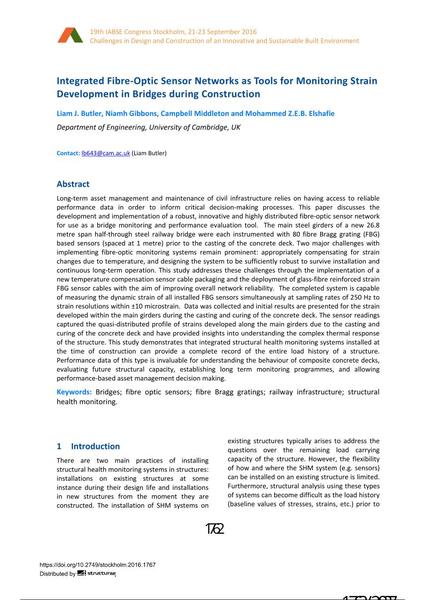Integrated Fibre-Optic Sensor Networks as Tools for Monitoring Strain Development in Bridges during Construction

|
|
|||||||||||
Détails bibliographiques
| Auteur(s): |
Liam J. Butler
(Department of Engineering, University of Cambridge, UK)
Niamh Gibbons (Department of Engineering, University of Cambridge, UK) Campbell Middleton (Department of Engineering, University of Cambridge, UK) Mohammed Z. E. B. Elshafie (Department of Engineering, University of Cambridge, UK) |
||||
|---|---|---|---|---|---|
| Médium: | papier de conférence | ||||
| Langue(s): | anglais | ||||
| Conférence: | IABSE Congress: Challenges in Design and Construction of an Innovative and Sustainable Built Environment, Stockholm, Sweden, 21-23 September 2016 | ||||
| Publié dans: | IABSE Congress Stockholm, 2016 | ||||
|
|||||
| Page(s): | 1762-1770 | ||||
| Nombre total de pages (du PDF): | 9 | ||||
| Année: | 2016 | ||||
| DOI: | 10.2749/stockholm.2016.1767 | ||||
| Abstrait: |
Long-term asset management and maintenance of civil infrastructure relies on having access to reliable performance data in order to inform critical decision-making processes. This paper discusses the development and implementation of a robust, innovative and highly distributed fibre-optic sensor network for use as a bridge monitoring and performance evaluation tool. The main steel girders of a new 26.8 metre span half-through steel railway bridge were each instrumented with 80 fibre Bragg grating (FBG) based sensors (spaced at 1 metre) prior to the casting of the concrete deck. Two major challenges with implementing fibre-optic monitoring systems remain prominent: appropriately compensating for strain changes due to temperature, and designing the system to be sufficiently robust to survive installation and continuous long-term operation. This study addresses these challenges through the implementation of a new temperature compensation sensor cable packaging and the deployment of glass-fibre reinforced strain FBG sensor cables with the aim of improving overall network reliability. The completed system is capable of measuring the dynamic strain of all installed FBG sensors simultaneously at sampling rates of 250 Hz to strain resolutions within ±10 microstrain. Data was collected and initial results are presented for the strain developed within the main girders during the casting and curing of the concrete deck. The sensor readings captured the quasi-distributed profile of strains developed along the main girders due to the casting and curing of the concrete deck and have provided insights into understanding the complex thermal response of the structure. This study demonstrates that integrated structural health monitoring systems installed at the time of construction can provide a complete record of the entire load history of a structure. Performance data of this type is invaluable for understanding the behaviour of composite concrete decks, evaluating future structural capacity, establishing long term monitoring programmes, and allowing performance-based asset management decision making. |
||||
| Mots-clé: |
ponts
|
||||
